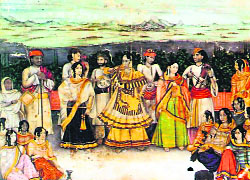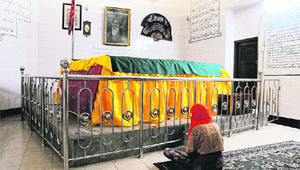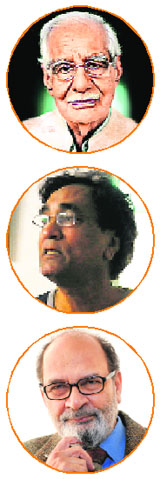|
The fading moments of Mughal glory
and the tragedy that followed the First War of Independence in 1857
have been revived in public memory as the campaign to bring back the
mortal remains of the last Mughal emperor Bahadur Shah Zafar is set
afloat
Bahadur Shah Zafar
Will exile end?
Nirupama Dutt

A painting depicting dancing girls in Delhi during Bahdur Shah Zafar’s reign |
The
lament of the last of the proud Mughal emperors, Bahadur Shah
Zafar, remains ever alive in the collective consciousness of the
subcontinent in which the emperor who was also a poet cried out of his
misfortune at not being able to avail of the two yards of land in his
beloved country: Kitna hai badnaseeb Zafar dafn ke liye/Do gaz
zameen bhi na mili koo-e-yaar mein. These two lines are embedded
in the Indian psyche are indeed a part of popular culture. This
couplet still has the power to sadden the human heart to let out a
helpless grieved sigh.
This summer a campaign
of sorts is being built to bring back the mortal remains of the
emperor back from Rangoon (now Yangon) in Myanmar. The campaigners of
this very just although somewhat delayed demand are a handful of
liberals and Leftists who see in Zafar a symbol of the composite
culture of pro-colonial India. These include the old guard like
journalists Kuldip Nayar and Saeed Naqvi, lawyer Rajinder Sachar,
historian Mushirul Hasan, Left-wing theatre artiste Shamsul Islam,
Prem Singh, general secretary, of the near-forgotten Socialist Party
of India.
 After a Press conference
in early May in New Delhi, a public meeting was held at the Law
Institute in the Capital but the old guard is rather surprised that
but for stray reporting, the media has not highlighted the campaign
with the emphasis that it required. After a Press conference
in early May in New Delhi, a public meeting was held at the Law
Institute in the Capital but the old guard is rather surprised that
but for stray reporting, the media has not highlighted the campaign
with the emphasis that it required.
In 2006, an initiative
had come from the government itself in this direction, a year before
the 150th anniversary of the War of Independence. A high-level meeting
was held at 7 Race Course Road, residence of Prime Minister Manmohan
Singh, attended by the who's who of Indian politicians, academics,
artists, writers and journalists. The Prime Minister raised the issue,
describing Zafar as the man who defined India's diversity, liberalism,
integrity and the national movement. All were in unison that the
remains of the emperor who suffered great tragedy should be brought
back and it would be poetic justice if these could be buried in the
two yards at a dargah in Mehrauli. The grave is still waiting
to be claimed for Zafar over a century and a half after he chose it.
Zafar's wish was to be buried in the dargah of Qutubuddin
Bakhtiar Kaki in Mehrauli and had earmarked two yards of land there. Dargah
caretakers have kept an empty grave to honour wishes of the
star-crossed emperor.
The Last Mughal

(Top) Bahadur Shah Zafar gate at the entrance to the Salimgarh Fort and (below) Zafar's grave in Yangon |

For all of them, Bahadur Shah Zafar is the symbol of composite and diverse
Indian culture. (Top) Journalist Kuldip Nayar, (centre) theatre artiste Shamsul Islam and (bottom) columnist Saeed Naqvi |
William Dalrymple in his
famed book, The Last Mughal describes the journey to the sad
exile thus: "At 4 am on October 7, 332 years after Babur first
conquered the city, the last Mughal Emperor left Delhi on a bullock
cart. Along with him went his wives, his two remaining children,
concubines and servants —a party of 31 in all... the journey had
been kept secret, even from Zafar himself, and the old man knew
nothing of his departure before being woken up at 3 am, and told to
get ready." There was no one to bid farewell to the emperor at
pre-dawn as he left his beloved Dilli forever. "Will people
succeed where the Government failed", asks Naqvi. He recalls the
2006 meeting, "Noted Gandhian, late Nirmala Deshpande's idea was
particularly well received. She suggested that soil should be brought
from Bahadur Shah Zafar's mazaar in Yangon for a memorial in
the Mehrauli dargah." Time and again the issue of bringing
back the remains is raised, it has not been followed up. Shamsul
Islam, founder of Nishant Natya Manch, who has started a signature
campaign, questions: "How long will Bahadur Shah Zafar's exile
continue?" He adds, "It is unfortunate that this commander
of India’s First War of Independence remains buried in a foreign
land. It is high time steps are taken to bring his remains to India so
that we and coming generations have the opportunity to emulate Zafar's
deeds for a free and secular India".
Burmese king
 Meanwhile, at the time
of his hasty burial in Yangon in November 1862, a bamboo fence
surrounded his grave and with grass growing over the precise spot was
lost for a long time and only in a restoration exercise as late as
1991 was the original brick-lined grave discovered. The Burmese
Muslims then built a shrine and Zafar is worshipped there as a Saint
to whom devotees go for wish fulfillment. Ironically, Zafar's own wish
remains unfulfilled. The sad chapters of colonial history tell that
while Zafar was exiled to Myanmar, King Thibaw of Burma (1859-1916)
was exiled to India and died pining for his land in Ratnagiri in
Maharashtra. Of late, Myanmar has been wanting the tomb of the King to
be relocated in his native country. Political dignitaries have not
responded to this civil-society demand that has yet to gather popular
momentum. Leader of the Opposition Sushma Swaraj is the perhaps the
only one who has warmly supported this campaign. The responses to her
statement on Twitter show that not many are interested setting the
wrongs of the faraway 1857 in present times. One response smirks at
concern for what happened over a 150 years ago, while another asks
about the ‘mortal remains’ of the BJP in Karnataka. The British
had showed callousness to the last Mughal and now it is indifference.
So is there a hope for the lost cause unless some smart Bollywood
director brings him back into public domain like Aamir Khan did to
Mangal Pandey, the rebel soldier who led the 1857 revolt? Meanwhile, at the time
of his hasty burial in Yangon in November 1862, a bamboo fence
surrounded his grave and with grass growing over the precise spot was
lost for a long time and only in a restoration exercise as late as
1991 was the original brick-lined grave discovered. The Burmese
Muslims then built a shrine and Zafar is worshipped there as a Saint
to whom devotees go for wish fulfillment. Ironically, Zafar's own wish
remains unfulfilled. The sad chapters of colonial history tell that
while Zafar was exiled to Myanmar, King Thibaw of Burma (1859-1916)
was exiled to India and died pining for his land in Ratnagiri in
Maharashtra. Of late, Myanmar has been wanting the tomb of the King to
be relocated in his native country. Political dignitaries have not
responded to this civil-society demand that has yet to gather popular
momentum. Leader of the Opposition Sushma Swaraj is the perhaps the
only one who has warmly supported this campaign. The responses to her
statement on Twitter show that not many are interested setting the
wrongs of the faraway 1857 in present times. One response smirks at
concern for what happened over a 150 years ago, while another asks
about the ‘mortal remains’ of the BJP in Karnataka. The British
had showed callousness to the last Mughal and now it is indifference.
So is there a hope for the lost cause unless some smart Bollywood
director brings him back into public domain like Aamir Khan did to
Mangal Pandey, the rebel soldier who led the 1857 revolt?
|
Befitting
memorial for Rani of Jhansi
The towering
figure of resistance to the Indians in the 1857 chronicle is
Rani Lakshmibai of Jhansi and Subhadra Kumari Chauhan's ballad
in tribute: Bundele harbolon ke munh hamne suni kahani thhi,
Khoob ladi mardani woh to Jhansi wali Rani thhi (We had
heard her tale from the mouths the Bundel bards, Bravely, like a
man, fought the queen of Jhansi) still gives goose pimples to
the listener or reader. This is so in spite of the gender
bender, so irksome to feminists, of "like a man".
Her popular image
is that of a handsome woman astride a horse, with her child tied
to her back, a shield in one hand and a sword in the other
fighting till her last breath, was a motivational force for the
National Movement. Saeed Naqvi says: "It is the statue of
Rani Jhansi that should be installed in the vacant canopy across
India Gate. This statue would be acceptable to every Indian,
irrespective of caste, creed or political allegiance." The
canopy has been vacant since the mid-1960s when it was removed
from there as it was a sad reminder of the humiliation and
torment of British colonial rule. However, Parliament could not
decide on the statue that should be put there as every leader's
name aroused a controversy. "There can be no controversy
over the image of the Jhansi wali Rani," says
veteran journalist Kuldip Nayar.
Emperor in
search of a director
Stories of
grandeur, justice, love and tragedy have always been sought
after in the glitter of Muslim historical films of Hindustani
cinema. Top of the charts was, of course, K. Asif's Mughal-e-Azam
(1960) with the king-prince conflict in the latter's romance
with an ill-fated dancing girl. Earlier, the same saga had been
told with some mesmerising music in Anarkali (1953). Then
there was the K. L. Saigal-starrer, Shahjahan (1946)
which told the story of the emperor's court poet Sohail's
unrequited love for the beautiful Ruhi and the subsequent death
of Mumtaz Mahal and the building of the Taj Mahal. The romantic
saga of Shahjahan and Mumtaz Mahal was set to lilting music in Taj
Mahal (1963). The tragedy of Shahjahan and his daughter
Jahanara as well as the tyranny of Aurangzeb enticed the
audiences in Jahanara (1964). The tragic saga of the king
who would be poet never quite caught the imagination of a
Bollywood director in spite of the wide gamut of emotions and
poetry that it offered. Lal Quila (1960) with Jairaj,
Nirupa Roy and Helen wilted in its B-grade handling. All that is
remembered of this non-starter are two of the ghazals sung
emotionally by Mohammad Rafi. There were some films on the 1857
War for Independence like Shatranj ke Khiladi (1977), Junoon
and Mangal Pandey (2005). None of these focused on
Zafar. B.R. Chopra did a tele-serial Bahadur Shah Zafar in
the 1980s with some of the good Urdu poetry of the times and
Ashok Kumar in the lead role. But the serial could not meet the
standards of Gulzar's Mirza Ghalib, with Naseeruddin Shah
playing the poet and Jagjit Singh singing the verses. Thus the
last of the Mughals, who may well be our own King Lear and more,
still awaits the magical touch on big or small screen. |
|